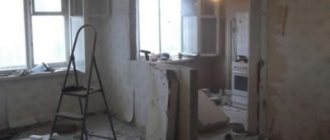- What not to do when remodeling an apartment
- Bathroom remodeling
- Kitchen remodeling
- Redevelopment with a kitchen niche
- Redevelopment of rooms with moving walls
- Redevelopment of a loggia or balcony
- What are the dangers of illegal redevelopment?
- What can be done during redevelopment
- What repairs can be done without a project?
- How to understand whether you can do redevelopment or not
The standard layout of the apartment can be made more convenient, to suit you. Demolish some walls to create more space. Or divide a large room into several small ones so that everyone in the family has their own room.
Despite the numerous possibilities for redevelopment, there are repairs that cannot be coordinated. For example, you cannot increase the room by adding a balcony or remove the door in the kitchen if there is a gas stove. It is better to know about this before remodeling your apartment, so as not to waste time and money on a project that cannot be implemented.
In this article we talk about what can and cannot be done when remodeling in specific rooms - in the kitchen, in the room, in the bathroom or on the balcony.
What not to do when remodeling an apartment
Redevelopment is those changes to the apartment that are reflected in its technical plan. Each apartment has this plan; it is stored in the BTI along with the registration certificate. If there is no BTI plan yet (for example, an apartment in a new building), you need to draw it up yourself. We talk about how to do this in this article.
Why do you need a technical plan for redevelopment:
- it shows the boundaries of all rooms, all doorways and window openings;
- All technical and plumbing equipment is marked.
This is an example of a floor plan issued by BTI.
Here you can see all the rooms of the apartment, their area. If you are renovating and planning to cut a new opening in the wall or move walls, be sure to first coordinate the redevelopment project. The planned work must comply with all building codes and sanitary rules. The safety of you and your neighbors living in your home depends on this. It is also important to agree on the repair so as not to receive a fine for illegal redevelopment and not to redo the repair.
Moscow Government Decree No. 508-PP - clause 10 of Appendix No. 1 lists all the work that is prohibited from being performed and cannot be agreed upon. Next, in simple language, we will talk about the prohibitions that apply to each specific room of the apartment.
What changes in the apartment cannot be legalized?
According to the norms of the Housing Code of the Russian Federation, there are a number of changes in residential premises, the implementation of which is not subject to approval and legalization. You cannot obtain permission in the following cases:
- If the redevelopment leads to a deterioration in the operating conditions of the house and people’s living conditions.
- If the modified premises and/or adjacent premises in the prescribed manner can be classified as unsuitable for habitation.
- If the redevelopment may affect premises that are registered with the headquarters for civil defense and emergency situations, and there is no appropriate permission to carry out this work.
- If, as a result of the work, the strength and stability of the load-bearing structures of the building may be impaired, which may lead to their destruction.
- If control and/or shutdown devices are installed on general apartment (common building) utility networks, when their use affects the amount of resource consumption in adjacent rooms.
- When the project involves reducing the cross-section or completely eliminating natural ventilation channels.
- When the loads on the load-bearing structures of the building seriously increase and exceed the permissible values according to the design (for example, when installing partitions made of heavy materials instead of partitions made of light materials, installing screeds in floors, placing additional equipment, etc.).
In standard residential buildings it is not allowed:
- Cutting niches, creating openings, punching holes in diaphragm walls, pylon walls and columns (pillars, racks), as well as in places where connections are located between prefabricated elements.
- Construction of additional openings in wall panels of adjacent height rooms without coordination with the design organization.
- Installation of grooves under internal wall panels and in horizontal joints, as well as in floor slabs and wall panels for placement of electrical wiring or piping.
Bathroom remodeling
Remodeling a bathroom is the most popular of all: the bathroom and toilet are combined, the bathroom is expanded to cover the area of the corridor. These are considered “wet areas” that need to be repaired correctly so that in the future you don’t flood your neighbors or worsen their living conditions and your living conditions.
Tells you what not to do when remodeling a bathroom.
- You cannot remove the threshold at the entrance to the bathroom. According to clause 4.8 of the Code of Rules 29.13330.2011 “Floors” at the entrance to the bathroom there must be either a threshold at least 2 cm high, or a different floor level in the bathroom and the corridor.
An example of how you can and cannot make a threshold in the bathroom.
Here are the main requirements for the threshold.
! A door frame, baseboard or glued-on piece of foam is not a threshold. It can be made of tiles, with waterproofing material placed on it.
- must not be touched—cut them, make them smaller, or use them as shelves and niches.
This is common property, and under no circumstances should it be used as a closet, moved, or reduced in size to the wall of the box. You can only hang a water heater inside it. If the boxes are on the BTI plan, then they must be preserved, even if the developer did not erect them.
This is how the boxes look on apartment plans.
- You cannot expand the bathroom if the neighbors have a living room below.
When expanding the bathroom onto the corridor area, you should always look at the BTI plans of the neighbors below. If they have already done a redevelopment and the corridor has become a living room, you cannot enlarge your bathroom, since the wet area should not extend into the living space of your neighbors. - You cannot lay tiles without waterproofing the floor. For any repair, it must be done, as there is a risk that pipes will leak, a faucet will break, or someone will forget to turn off the water. Waterproofing refers to hidden work, that is, those that are not visible during the finishing of the repair. To approve the redevelopment, you need to draw up an act on hidden waterproofing work signed by the construction organization.
- You cannot move the bathroom and toilet into the living part of the apartment, or expand the bathroom at the expense of the living room. This is only permissible in one case: if the apartment is on the ground floor. Then there are no neighbors below and there is no risk of flooding them with water in the event of an accident.
An example of all hidden work in an apartment that requires an inspection report:
Kitchen remodeling
There are many requirements for a kitchen renovation. The most stringent ones apply to kitchens with a gas stove. It is forbidden:
- you cannot reduce the kitchen so that its area is less than 8 square meters. m.. If it is initially smaller, and this is indicated in the BTI plan, then it should remain the same area - for example, 6 sq.m.;
- combine a kitchen with a gas stove and a living room without installing tightly closing doors or replacing the gas stove with an electric one. These can be regular doors, sliding or glass. Only plastic accordion doors are prohibited;
- move a gas stove without permission from the gas workers, even if the stove has a flexible connection;
- expand the gasified kitchen into the living room and vice versa in apartments on any floors. To combine the kitchen with the room, you need to replace the gas stove with an electric one. Then installing doors is not necessary.
For a kitchen with a gas stove, installing doors is mandatory.
Since gas is explosive, all work with gas equipment must be supervised by Mosgaz technicians. More information about all the requirements for moving a gas stove regarding risers and drainage can be found in our memo:





